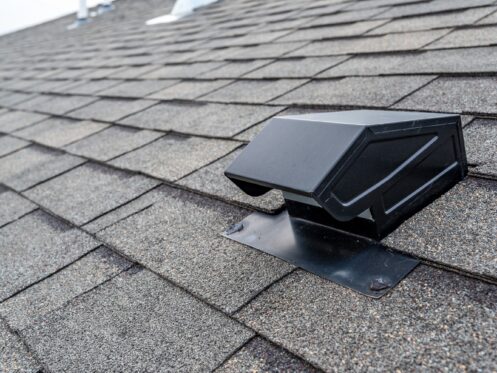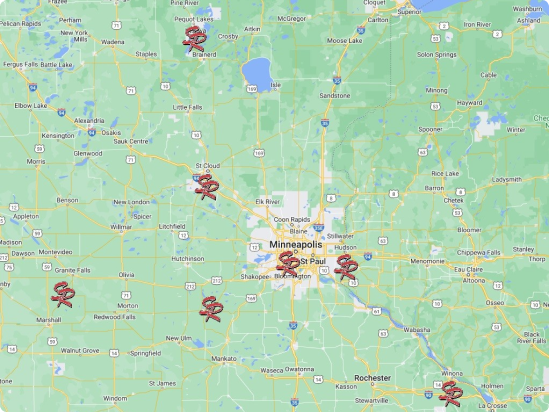Your roof isn’t just a cover—it’s your home’s first line of defense against the elements. And one of the unsung heroes of that defense? Roof flashing. This thin metal barrier seals up the weak spots around chimneys, vents, and skylights, keeping water from sneaking in. But flashing isn’t invincible.
If it cracks, rusts, or shifts out of place, your home is at risk for leaks, wood rot, and costly damage. The fix? Regular inspections and upkeep to make sure it stays in top shape. Schmidt Roofing in Burnsville, MN specializes in roof inspections, roof repairs, and flashing replacements to help keep your home dry and damage-free.
The Job of Roof Flashing
Your roof has to deal with a lot—rain, snow, wind, and heat. While shingles and tiles do most of the work, they can’t protect every part of the roof on their own. That’s where flashing comes in. Flashing is a thin metal material placed around chimneys, vents, skylights, and roof edges to seal up gaps where water might sneak in. Without it, even the smallest openings could let moisture seep into your home, leading to leaks, mold, and wood rot.
Think of flashing like the trim around your windows and doors. If that trim starts pulling away, gaps open up, and drafts or rainwater can get inside. The same thing happens with flashing. If it cracks, rusts, or shifts out of place, it stops doing its job. Once water gets past it, it can work its way into the attic, walls, or ceilings, causing damage you might not notice right away. That’s why flashing is a key part of any roof—it acts as the last layer of defense against leaks.
Common Types of Roof Flashing
Not all flashing looks the same. Flashing comes in different shapes and serves different purposes based on where it’s placed. Step flashing is layered like shingles along chimneys or walls to push water away. Valley flashing sits in the low spots where two roof sections meet, helping rainwater flow to the gutters. Drip edge flashing is placed along the roof’s edge to stop water from sneaking under the shingles.
The material also matters. Most flashing is made from aluminum, galvanized steel, or copper. Aluminum is light and easy to work with, but it needs a protective coating to prevent rust. Steel is strong and holds up well against rust, making it a common choice for roofs. Copper lasts the longest but costs the most and is usually found on high-end or historic homes.
Signs Your Roof Flashing Needs Repair
Flashing helps keep water out of your home, so if it gets damaged, trouble can follow. One big clue that flashing isn’t doing its job is water stains on your walls or ceiling. Paint peel, unattractive stains, and even mildew may result from a little leak soaking into wood and drywall.
Another thing to look for is rust or corrosion. While most flashing is built to handle exposure to the elements, years of rain and moisture can wear it down. Rusty or pitted flashing loses its ability to keep water out, and once it starts deteriorating, it needs to be replaced. If flashing is pulling away from the roof, that’s another warning sign. Strong winds, changing temperatures, or incorrect installation may cause flashing to bend, lift, or even fracture. Once gaps develop, water may pass through and cause further issues down the road.
What Causes Flashing to Fail?
Though strong, flashing is not unbeatable. A major factor of flashing failures is incorrect installation. In only a few years, it could loosen or move if it isn’t properly glued down or sealed with appropriate materials. Sometimes, roofers cut corners, using too little sealant or not overlapping flashing pieces the right way. This can lead to leaks even if the rest of the roof is in good shape.
Weather is another major factor. In areas with freezing temperatures, the cycle of expanding and contracting as temps rise and fall can weaken, flashing over time. Ice and snow sitting on the roof can also force water underneath to lose flashing, leading to leaks when it melts. Strong winds can bend or tear flashing from its place, leaving openings where rain can get in. Even normal aging can play a role—flashing that’s been exposed to decades of sun, rain, and wind will eventually wear down, no matter how well it was installed.
Fixing and Replacing Damaged Flashing
Early rather than later repairs of flashing that shows wear will help to prevent significant roof damage. Sometimes small cracks or gaps may be repaired using roofing cement or caulk; however, if flashing is rusted, deformed, or coming loose, it usually is beneficial to replace it. To produce a waterproof barrier, a damaged part is carefully removed, fresh flashing is installed, and then properly sealed.
Replacing flashing isn’t as simple as patching a hole in a wall. The surrounding shingles or roofing materials often need to be lifted or removed to install new flashing correctly. This is one reason a professional should perform flashing repairs; inadequate installation may cause far more difficulties. If you notice leaks near chimneys, vents, or skylights or see rusted or missing flashing, it’s worth scheduling an inspection to assess the damage.
Preventing Future Flashing Problems
The best way to keep flashing in good shape is with regular roof inspections. A professional can check for loose, cracked, or corroded flashing and catch minor issues before they turn into major leaks. Inspections are especially important after storms, strong winds, or freezing weather since these conditions are known to cause flashing damage.
Another way to prevent flashing failure is to keep an eye on your gutters. Clogged gutters can cause water to back up onto the roof, exposing flashing to excess moisture. Keeping gutters free guarantees water runs off the roof as it should, therefore lowering the risk of flashing damage. Reinforcing flashing with more sealant or changing to a more robust material might also be a wise long-term investment if you live in a location with regular storms or heavy snow.
Why Regular Roof Maintenance Matters
Flashing might not be the first thing you think of when it comes to roof care, but it plays a major role in keeping your home dry. At first, a little leak around a vent or chimney may not seem like a huge concern, but if unaddressed, it can lead to mold, wood rot, and costly structural damage. Checking your roof regularly and making sure flashing is secure can help prevent these issues before they start.
Having a professional inspect your roof at least once a year can save you from costly repairs. They can spot signs of flashing wear, check for loose sealant, and make sure everything is still watertight. If repairs are needed, addressing them quickly can keep water from sneaking into your home.
Flashing may not be the most noticeable part of your roof, but it’s one of the most important when it comes to preventing leaks. Keeping it in good condition ensures your home stays protected from water damage, no matter what the weather throws your way.
Schedule Your Roof Inspection
Roof flashing may not be the most noticeable part of your home, but it plays a huge role in preventing leaks and structural issues. A well-kept roof guarantees fewer surprises, less expensive repairs, and greater house protection.
If you’re unsure about the condition of your flashing, don’t wait until a leak appears. Schedule a roof inspection with Schmidt Roofing today. We also offer residential and commercial roof repair and roof replacement services.



